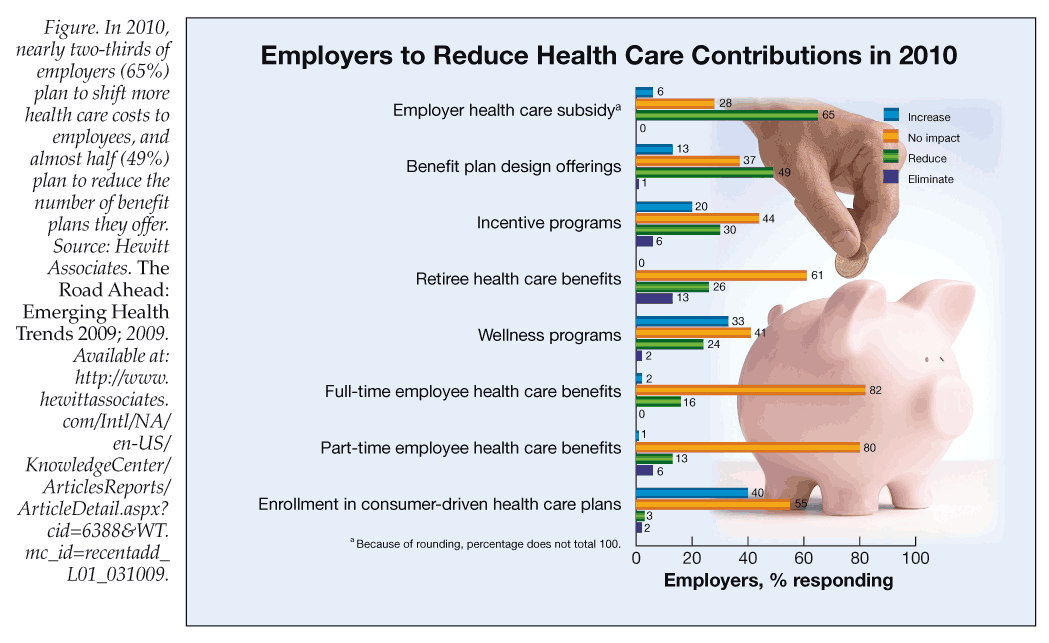One in 5 Employers Plan to Drop Health Benefs
Nearly one-fifth (19%) of US employers are taking steps to discontinue providing health care benefits during the next 3 to 5 years, up from just 4% in 2008, according to results of The Road Ahead: Emerging Health Trends 2009, a survey conducted for Hewitt Associates by project leader Jeffrey D. Munn. The team interviewed benefit executives at 343 large employers representing more than 5 million employees in December 2008 and January 2009.
Nearly one-fifth (19%) of US employers are taking steps to discontinue providing health care benefits during the next 3 to 5 years, up from just 4% in 2008, according to results of The Road Ahead: Emerging Health Trends 2009, a survey conducted for Hewitt Associates by project leader Jeffrey D. Munn. The team interviewed benefit executives at 343 large employers representing more than 5 million employees in December 2008 and January 2009.
While the state of the economy has had little influence on availability of health care programs in 2009, cost containment remains a priority among US employers. The number of companies focused solely on lowering annual health care costs has more than doubled, from 15% in 2008 to 31% in 2009. In addition, almost two-thirds (65%) of companies said they are continuing to invest in improving the health and productivity of their workforce.

However, more than half (52%) of companies said the economic downturn will have an effect on their 2010 health care programs (Figure). Overall, most employers are not planning to make significant changes to their health care benefits offered to employees in 2010 but are seeking to contain their health care costs. Nearly two-thirds (65%) of companies plan to shift more costs to employees; almost half (49%) plan to reduce the number of benefit plans offered.
In 2009, health insurance costs for companies are expected to increase by 6.4%, to an annual average cost of $8863 per employee. The combined average premium contribution and out-of-pocket costs for health care coverage for an employee is projected to rise nearly 9%, to $3826 a year. Annual employee contributions to premiums will rise nearly 8% this year, to $1946, which is about 22% of the overall premium amount. Employees will spend about $156 out of pocket each month on their health care, a 10.1% increase from 2008.
“Employers realize that short-term cost-management tactics do not address the underlying drivers of health care cost,” said James Winkler, MBA, head of Hewitt’s North America Health Management Consulting practice. “This leaves them with 2 options: making a long-term commitment to improving the health of employees or exiting health care."
Employers Target Diabetes, Cardiovascular Disease
The number of US employers intensifying efforts to manage the chronic health conditions of employees and their families rose dramatically during the past year. These findings are part of The Road Ahead: Emerging Health Trends 2009 survey conducted by Hewitt Associates (see above). About 80% of companies are targeting specific health conditions this year, up from 51% in 2008. The number of employers targeting diabetes and cardiovascular disease-2 of the most costly and most common chronic conditions in the United States-jumped by nearly 30 percentage points, from 46% and 40% in 2008 to 75% and 70%, respectively, this year. In addition, the number of companies targeting asthma increased from 36% to 56%, and almost one-third (32%) of companies are focusing on depression, which is almost twice as high as the past year’s percentage (17%).
Hewitt notes that the total annual cost of managing chronic health conditions in the United States is estimated to be $1.3 trillion, with $1.1 trillion associated with lost productivity and $277 billion spent on treatment. Hewitt estimates that a typical US employer with 9500 employees and 500 retirees younger than 65 years spends between $18 million and $22 million annually on direct medical care for persons with diabetes.
Employers with well-designed condition management programs that encourage healthy people to stay healthy and help at-risk individuals reduce their chances of becoming chronically ill will ultimately see the best returns. Even moderate changes in participant behavior can result in significant annual cost savings and a healthier workforce over time,” said Jennifer Boehm, a principal in Hewitt’s Health Management Consulting practice.
Health Insurance Options Mystify Most US Workers
Most US workers have a low awareness of and do not understand individual health insurance plans as well as have misperceptions about the cost of Consolidated Omnibus Budget Reconciliation Act (COBRA) coverage, according to a study by Aetna. Results of a survey of 290 adults 18 years and older found that 69% had never heard of individual health insurance plans or lacked familiarity with them. While general awareness of COBRA plans was higher, 38% of respondents said if they were unemployed, they expected that they would pay the same premiums as those they were paying when they were working.
The typical cost of COBRA coverage is 102% of the total premium, which is the actual cost of the health care plan and not just the amount deducted from employees’ pay. Without an employer contributing a portion of the premium payments, an individual may have to pay double or more to keep the same coverage. As part of the economic stimulus package, persons laid off between September 1, 2008, and December 31, 2009, who select COBRA coverage will receive a 65% subsidy of the total COBRA premium for up to 9 months.
“With more and more people entering the individual health insurance market, it is essential for them to have a clear understanding of all of the options that are available to them,” said Frank McCauley, head of Aetna’s Consumer Business Segment.
Podcast: Arthritis, Anxiety, and Depression: Managing a Common Comorbidity
May 14th 2012Anxiety is even more common than depression among people who have arthritis, a new study has shown. Here to discuss the implications for diagnosis and treatment is Eilzabeth Lin MD, a family medicine physician who is a longstanding researcher in the field of depression and pain.